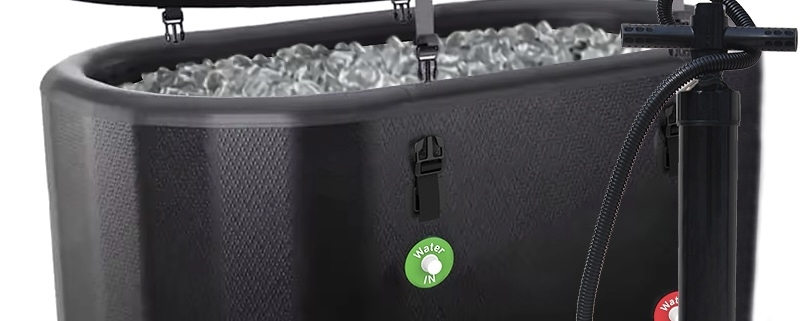Inflatable Ice Bath Tub vs. Framed Ice Tub: The Advantages of Inflatable Models
In the realm of health and sports recovery, ice baths have become a popular form of cold therapy. Two common types of ice bath equipment are inflatable ice bath tubs and framed ice tubs. While framed ice tubs have their merits, inflatable ice bath tubs are gaining popularity due to their portability, affordability, and ease of use. This article will compare these two products across multiple dimensions and explore the advantages of inflatable ice bath tubs.
1. Portability and Storage Convenience
Framed ice tubs are usually made of metal or rigid plastic with a sturdy structure, making them heavy and bulky. This limits their portability and makes storage challenging, especially when space is tight. In contrast, inflatable ice bath tubs, made from high-quality PVC or TPU materials, are extremely portable. When in use, they simply need to be inflated, and after use, they can be easily deflated and folded for storage.
For athletes and outdoor adventurers, the ability to transport their ice bath equipment to training locations or outdoor settings is a significant advantage. The inflatable model is lightweight and can be packed into a bag or car trunk, making it perfect for outdoor use. This portability appeals to users who need flexibility and travel often between different venues.
2. Ease of Setup and Use
Framed ice tubs, while providing a stable structure, can be cumbersome to set up. The assembly process may require tools and can take time, especially for users who aren’t handy. Inflatable ice bath tubs, on the other hand, are incredibly easy to set up. All you need is a pump to inflate it to the desired pressure, and you’re ready to go in minutes with no additional tools required.
For home users and rehabilitation centers, this simplicity is crucial. An inflatable ice bath tub allows users to quickly prepare for a cold plunge at home or in a therapy center without the hassle of complex assembly. This convenience makes it an ideal choice for those new to ice baths.
3. Comfort and User Experience
Framed ice tubs, being made of hard materials, may cause discomfort during extended use. The rigid walls can press against the body, making prolonged soaking uncomfortable. On the other hand, inflatable ice bath tubs are made from soft, flexible materials, providing a more comfortable experience. The inflatable walls conform to the body, enhancing comfort during the ice bath.
inflatable ice bath tubs allow users to adjust the water depth and air pressure according to their preferences, offering greater flexibility. This is especially important for home and personal users who want a comfortable cold water immersion without experiencing discomfort from a rigid structure.
4. Affordability and Cost-Effectiveness
Framed ice tubs, due to their more complex structure and use of rigid materials, tend to be more expensive. For users with budget constraints, purchasing a framed ice tub can represent a significant investment. Inflatable ice bath tubs, however, offer a more affordable option. Their simpler construction and lower production costs make them an attractive choice for those looking to try out cold therapy without a large financial commitment.
inflatable ice bath tubs are cheaper to maintain. They don’t require large storage spaces, and the durable materials used in modern designs ensure long-lasting use without frequent replacement. This further enhances the cost-effectiveness of inflatable models.
5. Versatility and Use in Various Settings
One of the key advantages of inflatable ice bath tubs is their versatility. They are not only ideal for home use but are also suitable for a range of outdoor activities and rehabilitation needs. For example, an inflatable ice bath tub can be used at camping sites or after outdoor sports to aid in recovery. Framed ice tubs, on the other hand, are better suited for fixed locations due to their weight and size, limiting their flexibility.
In rehabilitation centers or professional gyms, while framed ice tubs may provide a more permanent solution, inflatable ice bath tubs can be more easily integrated into personal recovery routines, offering a flexible and effective method for cold therapy. This versatility makes inflatable tubs a more attractive option in various contexts.
6. Maintenance and Durability
While framed ice tubs are generally more durable, especially in high-use commercial environments, inflatable ice bath tubs made from high-strength materials can also provide good longevity. Many modern inflatable models are constructed with reinforced materials that are resistant to tears and punctures, making them durable for repeated inflation and deflation.
For individual users or those with moderate usage needs, inflatable ice bath tubs are more than sufficient in terms of durability. Additionally, if damage occurs, repairs are relatively simple and cost-effective. For example, a damaged air valve or puncture can easily be fixed, which makes inflatable tubs a low-maintenance option.
Conclusion
While framed ice tubs have their advantages in certain professional settings, inflatable ice bath tubs are undoubtedly a more practical and accessible option for most users. Their portability, comfort, ease of setup, affordability, and versatility make them an ideal choice for athletes, fitness enthusiasts, and health-conscious individuals. Whether for home use or outdoor adventures, an inflatable ice bath tub offers a superior user experience and the flexibility to meet a variety of cold therapy needs. As more people look to incorporate ice baths into their recovery routines, inflatable models are likely to continue growing in popularity as the go-to solution for cold water immersion.




发表评论
Want to join the discussion?Feel free to contribute!